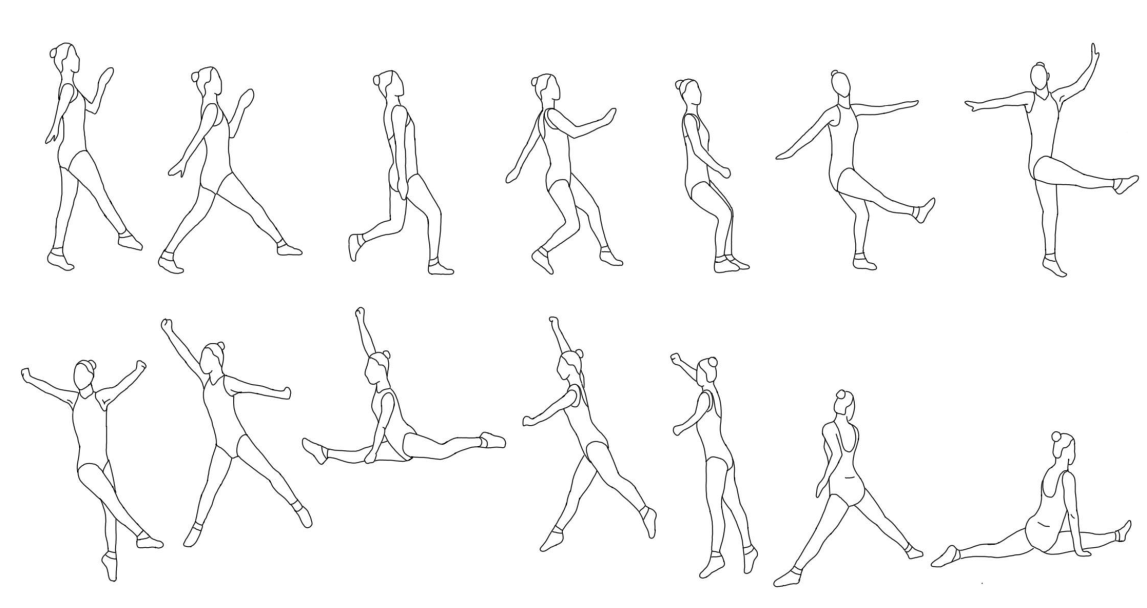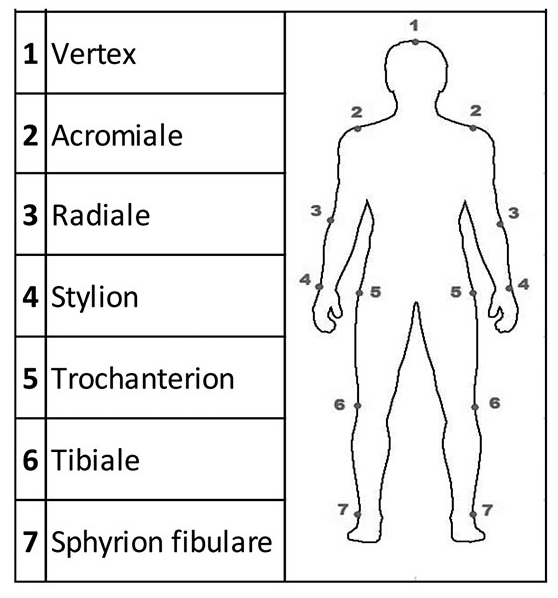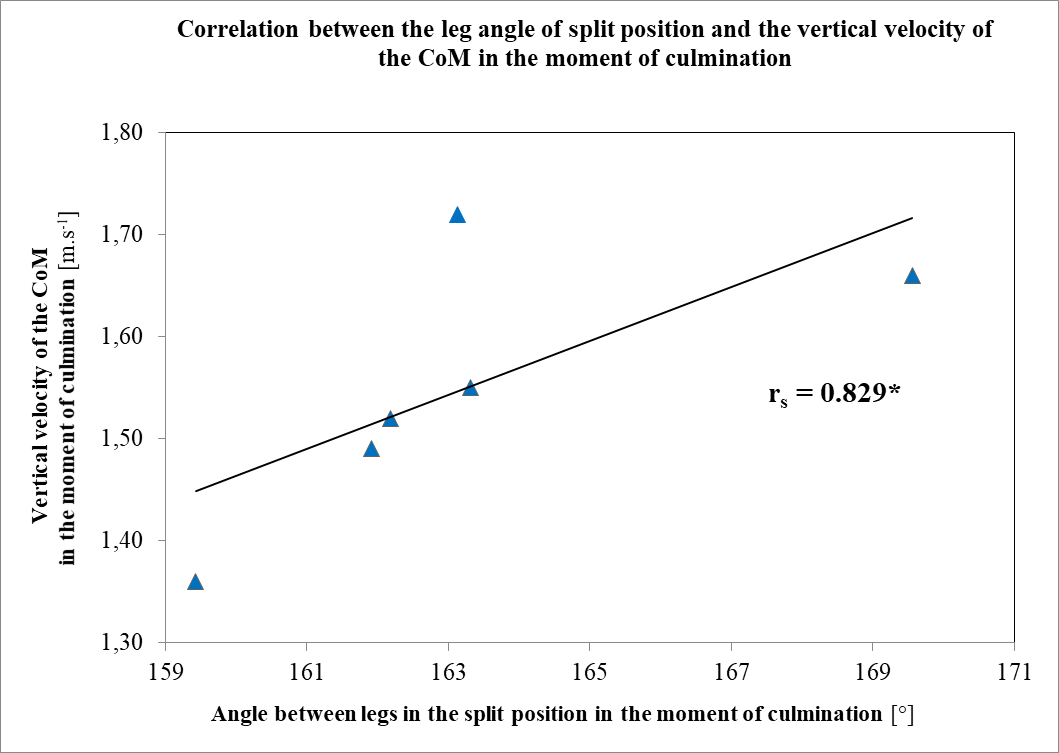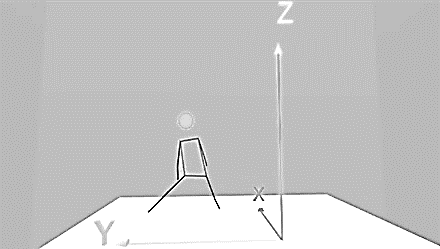Relationship of kinematic variables of selected aerobic gymnastic leap (kinematic characteristics of switch split leap)
ˑ:
Dr.Hab., PhD, Associate Professor O. Kyselovičova1
Associate Professor S.M. Lukina2
Master, postgraduate student Anita Lamoљova1
Master, postgraduate student Katarнna Pйliova1
Master, PhD Adriбna Krnбčova1
1Comenius University in Bratislava, Faculty of Physical Education and Sports, Slovakia
2Saint Petersburg State University, Saint Petersburg
Keywords: aerobic gymnastics, 3D analysis, kinematic characteristics, Switch Split Leap 1/1 Turn to Split.
Introduction. Effective development of sport performance is determined by the constant analysis of the key factors that influence the particular sport performances. As the technical requirements and the difficulties of the single skills and the entire routines in gymnastics have increased dramatically in the last years, the technique is one of the most important factors in gymnastics performance. Trying to improve the training process, means of modern technological equipment and methods are being used more and more often. Exploring the parameters that cannot be seen and analysed in details during the training process helps improve the training itself. Important elements of technique are revealed by the means of a 3-dimensional (3D) biomechanical analysis which consequently results in 1. enhancement of motor learning [14], 2. can minimize injuries, 3. providing the exact analysis of sport performance technique considering its strong and weak points [5, 6, 20, 21].
According to Kolar et al. [12] gymnastics has been categorised into a group of conventional sports, which are characterized with aesthetic and physically determined acyclic sets of structures. Conventionality of sports discipline implies that all movements must be performed in the context of a particular motor model.
Aerobic gymnastics - as one of the youngest and progressively expanding gymnastic sport, is defined as an aesthetic-technical discipline with the ability to perform continuous complex and high intensity aerobic movement patterns to music, which originates from traditional aerobic exercises: the routine must demonstrate continuous movement, flexibility, strength and various combinations of seven basic steps, with perfectly executed difficulty elements [8]. In addition, it combines elements of rhythmic gymnastics, and oftentimes artistic and acrobatics gymnastics along with music, dance and choreography. Thus, aerobic gymnastics routine involves many gymnastics and dance based skills, difficulty elements, with unique technical and artistic requirements. Since the aerobic gymnastics performance is characterised by the dynamics of movement with fast direction changes over the competition floor, a short-term persistence has the largest representation during the routine [15].
Hops, jumps and leaps are fundamental human movements (aerobic gymnastics as well) that require complex motor coordination of both upper and lower body segment [2]. Additionally, a variety of jumps and leaps are considered to be an important part of the aerobic gymnasts’ daily routines when the gymnasts transmit their impulse from the feet to the upper bodies following rebounds. The technical structure of aerobic gymnastics elements is prescribed in Code of Points (CoP) of aerobic gymnastics given by the International gymnastic federation (FIG) for each Olympic cycle [8]. The FIG CoP defines many different jumps, but the most preferred is the split leap. Thus, the purpose of the present study is to identify kinematic variables in the main phase of Switch Split Leap 1/1 Turn to Split and relationships between them with the aspect of correct technique.
Research methods and organization. The elite female aerobic gymnast, 5 times Slovak champion, a member of the national team and European and world championships participant (age 23 years; body weight 52 kg; body height 158 cm, % body fat 8.6) took part in the study. The object of our observation was a Switch Split Leap 1/1 Turn to Split, one of the elements approved by the FIG on the initiative of the Slovak Gymnastics Federation in the March, 2017 (Figure 1). The element was included in the CoP, group C – jumps and leaps and in the split jump family, evaluated for 0.7 points. The minimum requirement for split jump elements is to reach at least 170° in the split position [8].

Figure 1. Switch Split Leap 1/1 Turn to Split – take off, airborne phase and landing, performed in the competition.
After being informed on the procedures, methods, benefits and possible risks involved in the study, the subject reviewed and signed the consent form to participate in the study. The experimental protocol was performed in accordance with the Declaration of Helsinki for human experimentation and was approved by the university ethical committee. The investigation’s design contained six attempts with rest of 80 to 90 s between each of them. Spearman correlation analysis was carried out to check any relationship between the selected variables: the relationship between the leg angle of split position in the moment of culmination and the vertical velocity and the height of the centre of the mass (CoM) were measured. Statistical analyses were done using the software package SPSS version 13.0 (SPSS Inc., Chicago, IL, USA). The results were considered to be significantly different when the probability was less than or equal to 0.05 (p≤0.05). Data acquisition and testing were carried out in a laboratory setting. The element was executed on the surface provided by the laboratory with landing on a metal force plate. To eliminate tough landing a 3-cm thin mat was used (Figure 2). The entire recording and storage process used programme SIMI Motion 3D version 8.5 from the German company SIMI Reality Motion Systems GmbH based in Unterschleissheime. 8 synchronised high-speed industrial cameras were employed for the data collection. The marker based automatic tracking system calculate marker positions with possibility to track using markerless methods (Simi reality motion systems 2014). 13 markers were fixed to the reference anthropometric points prior to testing (Figure 3).

Figure 2. Landing force plate.

Figure 3. Reference anthropometric points
Results and discussion
Following the CoP [8] the leg angle of split position in the airborne phase must be minimum 170°. Our gymnast did not meet a minimum requirement in any of the six attempts (Table 1), with the value 169.56° and 159.43°, the best and the worst in this order (Figure 4). Considering that the split position in the moment of culmination is the most important phase of the element, we examined also the vertical height and vertical velocity of the centre of the mass in the moment of culmination (Table 1).
Table 1. Leg angle of split position, vertical velocity and height of CoM in the moment of culmination in all six attempts.
|
Attempt |
Leg Angle[°] |
Vertical Velocity [m.s-1] |
Vertical acceleration [m.s-1] |
Vertical Height [m] |
|
1. |
163.31 |
1.55 |
0.33 |
1.43 |
|
2. |
163.13 |
1.72 |
2.58 |
1.45 |
|
3. |
159.43 |
1.36 |
1.72 |
1.46 |
|
4. |
162.18 |
1.52 |
0.62 |
1.46 |
|
5. |
169.56 |
1.66 |
3.75 |
1.45 |
|
6. |
161.91 |
1.49 |
1.00 |
1.44 |
|
ā |
163.25 |
1.55 |
1.67 |
1.45 |
|
s |
3.39 |
0.13 |
1.30 |
0.01 |
Afterwards we set the results in the correlation with the vertical velocity and the height of the CoM. The results showed significant relation between the leg angle of split position and the vertical velocity on 5% level of probability with the correlation coefficient r = 0.829 (Figure 4) which is highly significant [10]. Comparing the leg angle of split position in the moment of culmination and the height of the CoM for not significantly related, moreover we noticed contradictory tendency, with the correlation coefficient r = - 0.441 (Figure 5).

Figure 4. Correlation between the leg angle of split position and the height of the CoM in the moment of culmination

Figure 5. Correlation between the leg angle of split position and the vertical velocity of the CoM in the moment of culmination.
Biomechanical considerations as reflected in correct or incorrect technique seems to be crucial. Based on the results of 3 D analysis we can identify errors of actual performance according to the proper technique of the jump (Figure 6): At the take-off phase the gymnast uses swing arm incorrectly, which should be straight. The analysis also showed the gymnast in the preparatory phase does not stretch arms sufficiently by reaching an average angle in the right elbow joint of 141.91 ± 8.18° and an average left elbow joint angle of only 140.75 ± 11.64 at the take-off. The result of such an effort may be then the bend knee joint of the push leg in the active phase of take-off, as the leg should be straight, at least 170-174° [3]. However, the average value of leg angle has reached only 159.41 ± 6.99°. The CoP minimum requirement – the angle at least 170° in the split position in the moment of culmination has not been accomplished. An additional major error here is the insufficiently stretched left leg in the knee joint where the average angle reached only 143.51 ± 2.3°. Insufficient torso rotation in the culmination phase is also evident and is the reason for the additional insufficient torso rotation in the landing. Following the error, the gymnast did not have finish the rotation in time prior to the landing in the split position, which resulted in incorrect landing. The back (swing) leg should be straight, however the average angle in the knee joint in the moment of contact of the hands with the floor reaches only 153.70 ± 3.54°.





Figure 6. Errors of actual execution according to the correct technique of the Switch split leap 1/1 turn to split at the take-off (a-b), an airborne phase (c) and landing (d-e).
Taking into consideration that the examined element Switch split leap 1/1 turn to split was a new element; our study had a pilot character. For this reason, there are not too many similar researches to compare with. Few studies have been published describing either anthropometric and physiological aspects or biomechanical characteristics of the specific difficulty elements in different gymnastic disciplines [1, 7, 9, 13, 19] or other related sports [11, 16-18].
The study of Cicchella [4] compares two similar leaps (cossack jump and cossack jump with ½ turn): inertial properties of lower limb flexion during flight seems to be the major determinants of longer flight times observed in movement with high inertial mass and velocity of displacement. Sousa & Lebre [22] analyse of split jumps performed by rhythmic gymnasts showed the importance of the velocity and the height of the CoM, which could be influence by many factors.
Conclusion
The present study examined the kinematic characteristics in the specific phases of selected difficulty element in aerobic gymnastics and correlation between them with the aspect of correct technique.
- The gymnast did not meet the CoP minimum requirement in any of the six trials. The closest attempt reached the value 169.56° (average angle = 163.25 ± 3.39°).
- According to Spearman correlation analysis the coefficient r = 0.829 representing high correlation between the vertical velocity of the CoM and the leg angle of the airborne split position. The height of the CoM in relation to the angle of split position in the moment of culmination was not proved as statistically related, moreover we found a negative tendency with coefficient r = - 0.441.
- Analysis of the results enabled us to reveal the errors in technique of the element. Additionally, it helps to ease the identification of the key phases, movement of the limbs and the CoM, resulting in enhancement of technical preparation.
- Transfer from our observation to sport praxis can help athletes and coaches in the practice of the element and elimination of the errors.
- It would be necessary to enlarge this 3D analysis of the particular difficulty element with dynamic indexes and try to create a model of technique with an exact description of kinematic and dynamic characteristics.
Aknowledgement. The study was supported by the project of the Ministry of education, science, research and sport of the Slovak Republic, VEGA No. 1/0824/17 and VEGA No. 1/0726/17.
References
- Aleksandraviciene R., Zaicenkoviene K., stasiule l., stasiulis a. Physiological Responses and Energetics of Competitive Group Exercise in Female Aerobic Gymnasts with Different Levels of Performance. Perceptual and Motor Skills, 2015, vol. 120, no. 3, pp. 787-803. Available at: https://journals.sagepub.com/doi/pdf/10.2466/29.26.PMS.120v15x7
- Ashby B.M., Heegaard J.H. Role of arm motion in the standing long jump. Journal of Biomechanics, 2002, vol. 35, no. 12, pp. 1631-1637. Available at: https://www.ncbi.nlm.nih.gov/pubmed/12445616
- Binovský A. Limbs connections. Anatomy for the athletes. Bratislava: Comenius University in Bratislava, 2010, pp. 131-154.
- Cicchella A. Kinematics analysis of selected rhythmic gymnastic leaps. Journal of Human Sport and Exercise, 2009, vol. 4, no. 1, pp. 40-47.
- Cihová I. Practical examples of using the two-dimensional analysis in evaluation of women triple jumps. Athletic 2006 – scientific textbook. Bratislava: ICM Agency, 2006, p. 248-251.
- Cihová I., Koštial J. Inter- and intra-individual changes of kinematic characteristics of women triple jumps. Kinematic structure of racing and training movement activity and its changes in training process of athletes from different specializations with regard to somatic characteristics. Bratislava: ICM Agency, 2005, p. 58-65.
- Farana R., Jandacka D., Uchytil J., Zahradnik D., IRWIN G. The influence of hand position on biomechanical injury risk factors at the wrist joint during the round-off skills in female gymnastics. Journal of Sports Sciences, 2017, vol. 35, no. 2, pp. 124-129.
- Federation Internationale de Gymnastique (FIG). Aerobic Gymnastics 2017 – 2020 Code of Points. 2017. Available at: http://www.fig-gymnastics.com/publicdir/rules/files/aer/AER_CoP_2017-2020-e_January_2017.pdf
- Hutchinson M.R., Tremain L., Christiansen J., Beitzel J. Improving leaping ability in elite rhythmic gymnasts. Medicine and Science in Sports and Exercise, 1998, vol. 30, no. 10, pp. 1543-1547.
- Chráska M. Methods of pedagogical research: Fundamental of quantitative research. Praha: Grada, 2007.
- Chren M., Britaňáková R., Čierniková I., Špánik M. Time-space kinematic analysis of rotation around the vertical axis of Latin American dancers. Biomechanical analysis of movement performance in dance and gymnastic sport: scientific textbook of the results VEGA 1/0954/16. Bratislava: Slovak scientific society for Physical Education and sport, 2018, p. 21-38.
- Kolar E., Piletič S., Bedenik K., Pavletič M.S., Štuhec S., Veličković S. Kinematic analysis of the new element “dimic” and its comparision with “Bilozerchev” on Parallel bars. Science of Gymnastics Journal, 2017, vol. 9, no. 1, pp. 83-96. Available at: https://www.fsp.uni-lj.si/en/research/scientific-magazines/science-of-gymnastics/previous-issues/2017022308290279
- Krnáčová A., Kyselovičová O., Péliová K. 2018. Kinematic characteristics of side somersault on the beam. Proceedings 11th International conference on kinanthropology "Sport and quality of life". Brno: Masaryk University, 2017, pp. 53-62.
- Kyselovičová O., Cihová I., 2008. Two-dimensional analysis of split jump in sport aerobic. Physical education and sport, 2008, vol. 18, no. 3-4, pp. 15-18.
- Mezei M., Cristea O. Performance criteria in Aerobic Gymnastics – Impact on the Sportive Training. Procedia – Soial and Behavioral Sciences, 2014, vol. 117, pp. 367-373. Available at: https://www.sciencedirect.com/science/article/pii/S1877042814017595
- Muyor J.M., Zemková E., Chren M. Effects of Latin style professional dance on the spinal posture and pelvic tilt. Journal of Back and Musculoskeletal Rehabilitation, 2017, vol. 30, no. 4, pp. 791-800. Available at: https://www.ncbi.nlm.nih.gov/pubmed/28372311
- Muyor J.M., Zemková E., Štefániková G., Kotyra M. Concurrent validity of clinical tests for measuring hamstring flexibility in school age children. International Journal of Sports Medicine, 2014, vol. 35, no. 8, pp. 664-669. Available at: https://www.ncbi.nlm.nih.gov/pubmed/24424962
- Olej P., Vasilčák T., Zvonař M., Lednický A. Kinematic analysis of the acrobatic element Back Layout Somersault in acrobatic rock and roll. Biomechanical analysis of movement performance in dance and gymnastic sport: scientific textbook of the results VEGA 1/0954/16. Bratislava: Slovak scientific society for Physical Education and sport, 2018, p. 66-82.
- Rodríguez G.M., Gómez-Landero Rodríguez L.A. Performance variables and technical penalties of the split leap. Revista Internacional de Medicina y Ciencias de la Actividad Física y del Deporte, 2018, vol. 18, no. 72, pp. 605-619. Available at: http://cdeporte.rediris.es/revista/revista72/artvariables966.htm
- Sebera M., Joukal S., Zvonař M. 3D biomechanical analysis in athletic. Brno: Masaryk University, Faculty of Sport Studies, 2012, 6 p. Available at: https://is.muni.cz/do/fsps/e-learning/2D-3D-analyza-po/pdf/simi-3D-biomechanicka-analyza-v-atletice.pdf
- Soumar L. Kinematic analysis. Ústí nad Labem: University J. E. Purkyně in Ústí nad Labem, 2011, 52 p.
- Sousa F., Lebre E. Biomechanical analysis of two different jumps in Rhythmic sports gymnastics (RSG). 2010, pp. 416-419. Available at: https://ojs.ub.uni-konstanz.de/cpa/article/viewFile/2754/2600
Corresponding author: fizkult@teoriya.ru
Abstract
Although many variables influence success in the sport, biomechanical considerations as reflected in correct or incorrect technique, particularly in gymnastics are more than decisive. The present study analyses relationships of the kinematic characteristics of Switch Split Leap 1/1 Turn to Split in culmination phase, executed by the Slovak aerobic gymnastic champion (age = 23 years, height = 158 cm, body weight = 52 kg). The indicators that appear to be a key in terms of correct technique were measured: the angles between the body segments, the height and velocity of the centre of the mass. Measurements were carried out by Simi Motion 3D system in the Laboratory of Biomotorics Faculty of Sports Studies, Masaryk University in Brno, Czech Republic. Eight synchronised industrial cameras were used to collect the data. Spearman's analysis confirmed the high degree of dependence between the leg angle of split position and the velocity at the culmination (r = 0.829). On the contrary, the correlation between the leg angle of split and the height of the centre of the mass was manifested as non-significant (r = -0.441).

